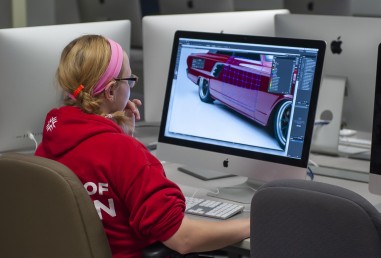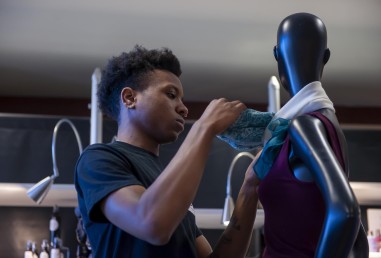
Program Overview
Program Details
Canadian Students
Full Time Offerings
International Students
Full Time Offerings
Your Learning Experience
Fashion Design is a three-year co-operative Ontario College Advanced Diploma program providing professional career-directed training in the development, production management and marketing of apparel design. Through classroom theory, lecture, lab work, field trips and work term experience, skills are applied. Networking with industry professionals promotes future employment opportunities. Emphasis is placed on design analysis, apparel manufacturing and technology, and design communications and marketing.
You’ll develop skills in creative design, visual communication, business marketing and apparel production technologies. You’ll also learn practical skills like fashion illustration, computer aided design, pattern-making and draping and garment construction. The third year of study culminates with a capstone project, where students concept, produce and present a final collection.
Apply your skills throughout the program in a combination of lab work, field trips, and working semester experiences, as well as in a variety of research opportunities. Our faculty are committed to research opportunities through industry and community partnerships that move the industry forward. With these experiences, you’ll graduate with a professional portfolio and the skills to work in a variety of jobs in the fashion and apparel industry.
Skills such as fashion illustration, computer-aided design, pattern-making and draping, and apparel construction techniques are taught, and supported by studies of textile technology, historical research, manufacturing processes and applied computerized technology in the fashion industry. The program fosters creative and independent problem solving in students, preparing them for a future in the various sectors of the rapidly changing fashion and apparel industry.
Co-op Opportunities & Career Information
Co-op Opportunities
The Fashion Design program offers a cooperative education component, which provides students the opportunity to gain invaluable first-hand workplace experience in their chosen field. Here are some co-op jobs that have kick-started the careers of some Fashion Design students before even graduating!
Assistant Designer
Aide in the creation of an apparel line through illustration, cutting, stitching and pattern tracing.
Production Assistant
Assist in the quality control and efficient production of products.
Sewer/Tailor
Custom garments according to client needs. Repurpose something vintage, or simply alter a piece for continued wear.
For more information regarding co-op, please check out our co-op site or contact the Co-op Office at coop@fanshawec.ca to connect with a consultant.
Career Information
With a passion for fashion and an eye for design, graduates of Fanshawe’s Fashion Design program can make that quote come alive in a rewarding career working in positions of:
● development production
● production in apparel manufacturing
● designers
● assistant designers
● technical designers
● computerized fashion illustrators
● pattern makers
● graders
● quality controller technicians
● CAD aided design technologists
● independent designers or consultants
Did you know Fanshawe consistently ranks high in graduation employment rates among large colleges in Ontario?
Here are some examples of career opportunities for graduates of Fanshawe’s Fashion Design program:
Technical Designer
Set up, maintain and update style summaries, create technical sketches for design, track and relate all changes and modifications from fit meetings to suppliers.
Fashion Designer
Manufacture, produce, market and sell streetwear.
Seamstress – Bridal and Special Occasion Wear
Complete flawless alterations including hems, bustles and custom requests.
Progression Chart
Fall intake
| Year | Fall | Winter | Summer |
|---|---|---|---|
| Year 1 | Level 1 | Level 2 | *Co-op (see below) |
| Year 2 | Level 3 | Level 4 | *Co-op (see below) |
| Year 3 | Level 5 | Level 6 | *Co-op (see below) |
* Two co-op terms in the summer (May to August) after Year 1, 2 or 3.
Winter intake
| Year | Fall | Winter | Summer |
|---|---|---|---|
| Year 1 | n/a | Level 1 | Level 2 |
| Year 2 | Level 3 | Level 4 | Co-op 1 |
| Year 3 | Level 5 | Level 6 | Co-op 2 |
Learning Outcomes
The graduate has reliably demonstrated the ability to
- Recognize the interrelationships among designers, manufacturers, merchandisers and consumers in the domestic and global marketplace;
- Create innovative, sustainable and inclusive designs using flat pattern and 3D prototyping techniques that incorporate design and fitting principles;
- Use most current computer technologies to design, digitally communicate, market and manufacture apparel;
- Demonstrate a thorough understanding of materials, colours, silhouettes, textures and techniques in order to communicate a reflective design process incorporating market research and analysis to solve design problems;
- Source materials, illustrate concepts, develop patterns, produce technical packages and costing information, apply production specifications to produce apparel that incorporates both sustainability, and human-centered designs;
- Analyse the organizational functions, systems and logistics in the manufacturing and marketing of fashion and apparel;
- Apply business principles that foster entrepreneurship from both a social and sustainable perspective;
- Adapt global fashion trends from the historical, current, and future perspective to produce marketable designs for consumers;
- Produce and present work that meets the standards, ethics and practices of the domestic and global fashion industry;
- Apply visual communication skills to develop products, support design collaborations and create a professional portfolio;
- Operate industrial sewing, pressing and other technical equipment safely and to industry standards.
Academic School
Fashion Design Program Coordinator:
Leigh-Ann Waller
Admission Requirements
International Admission Equivalencies
English Language Requirements
English Language Requirements
Applicants whose first language is not English will be required to demonstrate proficiency in English by one of the following methods:
- A Grade 12 College Stream or University Stream English credit from an Ontario Secondary School, or equivalent, depending on the program's Admission Requirements
- Test of English as a Foreign Language (TOEFL) test with a minimum score of 79 for the Internet-based test (iBT), with test results within the last two years
- International English Language Testing System (IELTS) Academic test with an overall score of 6.0 with no score less than 5.5 in any of the four bands, with test results within the last two years. SDS Program Requirements.
- Canadian Academic English Language (CAEL) test with an overall score of 60 with no score less than 50 in any of the four bands, with test results within the last two years
- Pearson Test of English Academic (PTE) with a minimum score of 53, with test results within the last two years
- A Cambridge English Test (FCE/CAE/CPE) with an overall score on the Cambridge English Scale of 169 with no language skill less than 162, with test results within the last two years
- Fanshawe College ESL4/GAP5 students: Minimum grade of 80% in ESL4/GAP5 Level 8, 75% in ESL4/GAP5 Level 9, or 70% in ESL4/GAP5 Level 10
Recommended Academic Preparation
Recommended Academic Preparation
- Grade 12 Drama (M)
- Grade 11 Understanding Fashion (C) AND/OR Grade 12 The World of Fashion (M)
- Grade 12 Business and Technological Communication (O)
- Keyboarding Skills
- Architectural Drafting Skills
Recommended Personal Preparation
Recommended Personal Preparation
- Students are encouraged to develop strong fashion drawing and sketching qualities using various techniques
- A strong sewing background is very important
- A personal interest in global fashion awareness in industry, textiles and computer
Applicant Selection Criteria
Applicant Selection Criteria
Where the number of eligible applicants exceeds the available spaces in the program, the Applicant Selection Criteria will be:- Preference for Permanent Residents of Ontario
- Receipt of Application by February 1st (After this date, Fanshawe College will consider applicants on a first-come, first-served basis until the program is full)
- Achievement in the Admission Requirements
Post-Admission Requirements
Post-Admission Requirements
Courses
| Level 1 | ||||
| WRIT-1036 | Reason & Writing 1-Art & Design | 3 | ||
This course introduces students to essential principles of reading, writing, and reasoning at the postsecondary level. Students will identify, summarize, analyze, and evaluate multiple short readings and write persuasive response essays to develop their vocabulary, comprehension, grammar, and critical thinking. | ||||
| DRAF-1057 | Pattern Making 1 | 3 | ||
In this course, the student is introduced to the fundamental skills of pattern making. Areas of concentration will be skirt and pant pattern development. Students will also learn the role of the master pattern (block) in developing design concepts. | ||||
| ARTS-1024 | Fashion Drawing & Theory | 2 | ||
This course introduces the student to the fundamental skills of fashion drawing for the fashion designer. These include the use of line, space shape, texture and colour. Further studies include the application of proportions, balance and movement to the fashion figure. Students will be introduced to a variety of medium to encourage their drawing skills. The students will become acquainted with the use of a designer croquis as a fashion drawing tool. Students will complete final fashion composition presented and mounted in a professional manner. | ||||
| DESG-1062 | Sample Room Production 1 | 3 | ||
The focus of this course is to teach the students the theory, processes, and the quality standards behind the construction of the designer's first samples. Students will learn to sew and produce various samples that will support the production of their Design Studio 1 skirt prototype. | ||||
| FASH-1003 | Design Studio 1 | 2 | ||
An introduction to fashion design literacy, visual communication and engagement with sustainable design communities. Design studio 1 explores the creative design process through the study of the elements and principles of design with a series of innovation workshops. Students will apply and practice the design process through the development of a fashion designer's inspiration sketchbook. Students will explore a variety of research methods, digital online platforms, 2 D & 3 D creative problem solving processes to express innovation in sustainable design. | ||||
| FASH-1005 | Fashion Industry Analysis | 2 | ||
This course provides the students with an introduction to the principles in which the fashion world revolves; and the role of economic, sociological and psychological elements in the fashion cycle. The course includes an overview of the fashion industry focusing on design, product development, manufacturing, marketing and retailing. Students will research contemporary fashion designers and examine their roles and influences on current fashion trends. | ||||
Tuition Summary
London
*Total program costs are approximate, subject to change and do not include the health and dental plan fee, bus pass fee or program general expenses.





